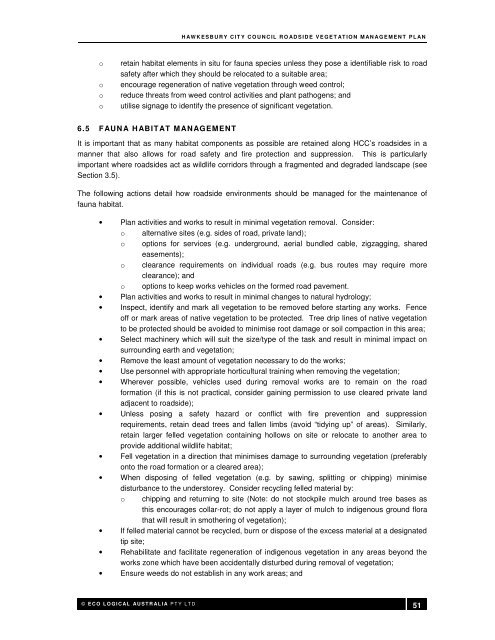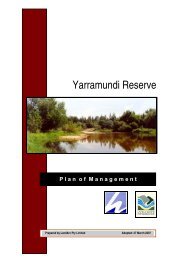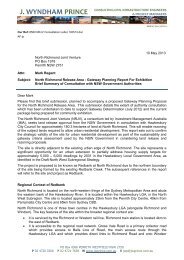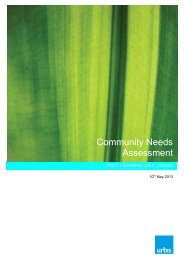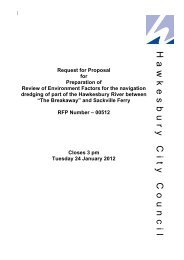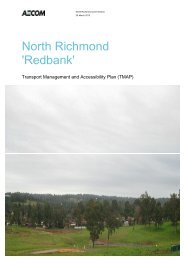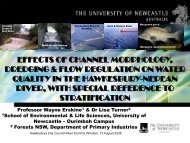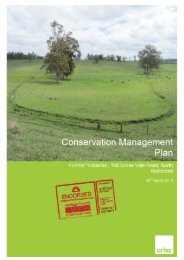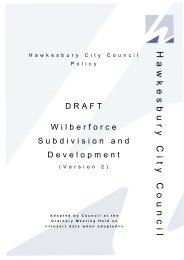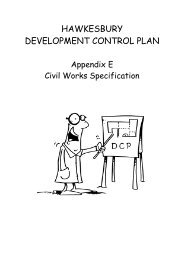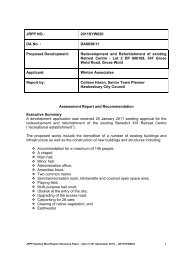Attachment 1 to Item 53 - Roadside Vegetation Management Plan
Attachment 1 to Item 53 - Roadside Vegetation Management Plan
Attachment 1 to Item 53 - Roadside Vegetation Management Plan
Create successful ePaper yourself
Turn your PDF publications into a flip-book with our unique Google optimized e-Paper software.
H AW K E S B U R Y C IT Y C O U N C IL R O AD S ID E V E G E T AT IO N M AN AG E M E N T P L AN<br />
o<br />
o<br />
o<br />
o<br />
retain habitat elements in situ for fauna species unless they pose a identifiable risk <strong>to</strong> road<br />
safety after which they should be relocated <strong>to</strong> a suitable area;<br />
encourage regeneration of native vegetation through weed control;<br />
reduce threats from weed control activities and plant pathogens; and<br />
utilise signage <strong>to</strong> identify the presence of significant vegetation.<br />
6.5 FAUNA HABITAT MANAGEMENT<br />
It is important that as many habitat components as possible are retained along HCC’s roadsides in a<br />
manner that also allows for road safety and fire protection and suppression. This is particularly<br />
important where roadsides act as wildlife corridors through a fragmented and degraded landscape (see<br />
Section 3.5).<br />
The following actions detail how roadside environments should be managed for the maintenance of<br />
fauna habitat.<br />
• <strong>Plan</strong> activities and works <strong>to</strong> result in minimal vegetation removal. Consider:<br />
o alternative sites (e.g. sides of road, private land);<br />
o options for services (e.g. underground, aerial bundled cable, zigzagging, shared<br />
easements);<br />
o clearance requirements on individual roads (e.g. bus routes may require more<br />
clearance); and<br />
o options <strong>to</strong> keep works vehicles on the formed road pavement.<br />
• <strong>Plan</strong> activities and works <strong>to</strong> result in minimal changes <strong>to</strong> natural hydrology;<br />
• Inspect, identify and mark all vegetation <strong>to</strong> be removed before starting any works. Fence<br />
off or mark areas of native vegetation <strong>to</strong> be protected. Tree drip lines of native vegetation<br />
<strong>to</strong> be protected should be avoided <strong>to</strong> minimise root damage or soil compaction in this area;<br />
• Select machinery which will suit the size/type of the task and result in minimal impact on<br />
surrounding earth and vegetation;<br />
• Remove the least amount of vegetation necessary <strong>to</strong> do the works;<br />
• Use personnel with appropriate horticultural training when removing the vegetation;<br />
• Wherever possible, vehicles used during removal works are <strong>to</strong> remain on the road<br />
formation (if this is not practical, consider gaining permission <strong>to</strong> use cleared private land<br />
adjacent <strong>to</strong> roadside);<br />
• Unless posing a safety hazard or conflict with fire prevention and suppression<br />
requirements, retain dead trees and fallen limbs (avoid “tidying up” of areas). Similarly,<br />
retain larger felled vegetation containing hollows on site or relocate <strong>to</strong> another area <strong>to</strong><br />
provide additional wildlife habitat;<br />
• Fell vegetation in a direction that minimises damage <strong>to</strong> surrounding vegetation (preferably<br />
on<strong>to</strong> the road formation or a cleared area);<br />
• When disposing of felled vegetation (e.g. by sawing, splitting or chipping) minimise<br />
disturbance <strong>to</strong> the unders<strong>to</strong>rey. Consider recycling felled material by:<br />
o chipping and returning <strong>to</strong> site (Note: do not s<strong>to</strong>ckpile mulch around tree bases as<br />
this encourages collar-rot; do not apply a layer of mulch <strong>to</strong> indigenous ground flora<br />
that will result in smothering of vegetation);<br />
• If felled material cannot be recycled, burn or dispose of the excess material at a designated<br />
tip site;<br />
• Rehabilitate and facilitate regeneration of indigenous vegetation in any areas beyond the<br />
works zone which have been accidentally disturbed during removal of vegetation;<br />
• Ensure weeds do not establish in any work areas; and<br />
© E C O L O G I C AL AU S T R AL I A P T Y L T D<br />
51


